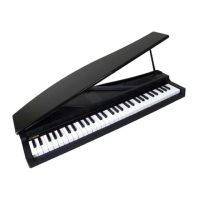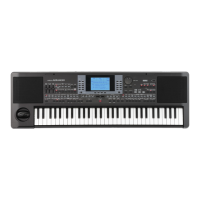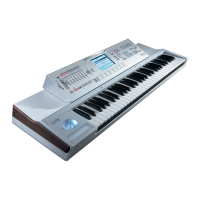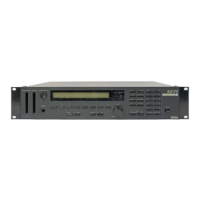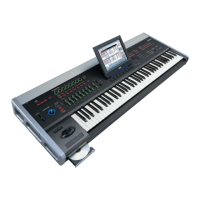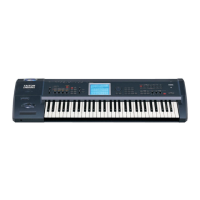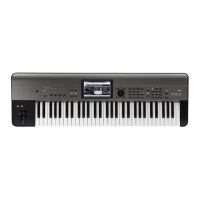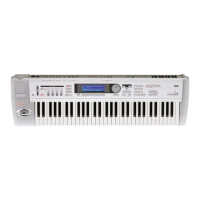120
Program operating mode
Page 17 - LFO1
Amp EG ‘Time’ modulation
These parameters let you use an alternate modulation
sourcetomodifythe ampEGtimesthatwerespecified
in“Attack/Decay/Slope/ReleaseTime”onpage119.
AMS1(T) (Alternate Modulation Source 1 - Time)
Thisparameterspecifiesthesourcethatwillcontrolthe
“Time” parameters of the amp EG (see “A M S (Alter‐
nateModulationSource)list”onpage123).Wit
haset‐
tingofOff,therewillbenomodulation.
Intensity
Thisparameterspecifiesthedepthanddirectionof the
effect that “AMS1” will have. For example, if
“AMS1(T)” is Amp KTrk +/+, the (Amp) Keyboard
Track settings (see “A m p l i f i e r key
board tracking
” on
page117)willcontroltheEG“Time”parameters.With
positive(+)valu
esofthisparameter,positive(+)values
of “Ramp (Ramp Setting) will cause EG times to be
lengthened, and negative (–) values of “Ramp (Ramp
Setting)” will cause EG times to be shortened. The
direction of the change is specified by “Attack Tim
e
Swing”, “Decay Time Swing”, “Slo
pe Time Swing”,
and“ReleaseTime
”.
When “AMS1(T)”
is Velocit
y , positive (+) values will
causeEGtimestolengthenasyouplaymorestrongly,
andnegative(–)valueswillcauseEGtimestoshorten
asyouplay more strongly. Withasetti ng of 0, theEG
times will be as specified by the “A m p env
elope”
parameters(seepage119).
Attack Time Swing
Thisparameterspecifiesthedirectionoftheeffectthat
“AMS1” willhave on “Attack Time”. Withpositive(+)
va
lues of “Intensity”, setting this parameter to + will
allow AMS1 to lengthen the time, and setting it to –
willallowAMS1toshortenthetime.Withasettingof0
therewillbenoeffect.
Decay Time Swing
Thisparameterspecifiesthedirectionoftheeffectthat
“AMS1” will haveon “Decay Time”. With positive(+)
values of “Intensity”, setti
ng this parameter to + will
allow AMS1 to lengthen the time, and setting it to –
willallowAMS1toshortenthetime.Withasettingof0
therewillbenoeffect.
Slope Time Swing
Thisparameterspecifiesthedirectionoftheeffectthat
“AMS1” will have on “Slope Time”. With positive (+)
values of “Intensity”, setti
ng this parameter to + will
allow AMS1 to lengthen the time, and setting it to –
willallowAMS1toshortenthetime.Withasettingof0
therewillbenoeffect.
Release Time
Thisparameterspecifiesthedirectionoftheeffectthat
“AMS1”willhaveon“ReleaseTime”.Withpositive(+)
va
lues of “Intensity”, setting this parameter to + will
allow AMS1 to lengthen the time, and setting it to –
willallowAMS1toshortenthetime.Withasettingof0
therewillbenoeffect.
AMS2 (Alternate Modulation Source 2)
This is another alternate modulation source for the
AmpEG.Seeabove“AMS1”parameters.
PAGE 17 - LFO1
Inthisandthenextpageyoucanmakesettingsforthe
LFOthatcanbeusedtocyclicallymodulatethe Pitch,
Filter, and Amp of ea choscillator. There are two LFO
units for each oscillator. Bysetting theLFO1 or LFO2
Intensity to a negative (–) value for Pitch, Filter, or
Amp,yo
ucaninverttheLFOwav
eform.
Wave
This parameter selects the LFO waveform. The num‐
bersthatappearattherightofsomeoftheLFOwave‐
forms indicate the phase at whi
ch the wavef
orm will
begin.
Frequency
SettheLFOfrequency.Asettingof99isthefastest.
00…99 Frequencyrate.
Amp 1 EG changes (Time) (AMS=Velocity, Intensity= a positive (+) value)
Amp 1 EG changes (Time)
(AMS=Amp KTrk +/+, Intensity = a positive (+) value)
(When Amp Keyboard Track “Low Ramp”= a positive (+) value, and
“High Ramp” = a positive (+) value)
Note-on
Note-off
Note-on
Note-off
Note-on
Note-off
Note-on
Note-off
Note-on
Note-off
Note-on
Note-off
Low-pitched note played with
Attack, Decay, Slope, and
Release Time Swing at +
Softly played note with
Attack, Decay, Slope and
Release Time Swing at +
High -pitched note played with
Attack, Decay, Slope, and
Release Time Swing at –
Strongly played note with
Attack, Decay, Slope and
Release Time Swing at +
Strongly played note with
Attack, Decay, Slope and
Release Time Swing at –
Triangle wave
Phase will change
randomly at each key-in
Sawtooth down
Square wave
Sine wave
Guitar vibrato
Triangle 0
Triangle 90
Triangle
Random
Saw 0
Saw 180
Square
Sine
Guitar
Exponential
Triangle
Exponential
Saw Down
Exponential
Saw Up
Step Triangle – 4
Step Triangle – 6
Step Saw – 4
Step Saw – 6
Random1 (S/H):
Conventional sample & hold (S/H) in which the
level changes randomly at fixed intervals of
time
Random2 (S/H):
Both the levels and the time intervals will
change randomly.
Random3 (S/H):
The maximum level and minimum level will
alternate at random intervals of time (i.e., a
square wave with random period).
Random4 (Vector)
Random5 (Vector)
Random6 (Vector)
These types cause Random 1–3 to change
smoothly. They can be used to simulate the
instability of acoustic instruments etc.
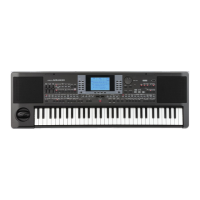
